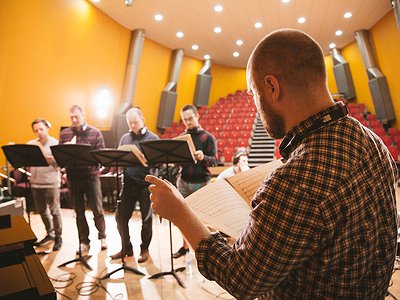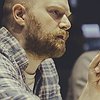Collaborations can take on many forms. What role do they play in your approach and what are your preferred ways of engaging with other creatives, including the artists performing your work?
A lot of this comes down to experience and people skills. Identifying the sound you want and then finding the appropriate musicians, which means knowing the strengths of the musicians you are choosing from. This comes from attending their shows and conversation — the muso community is great in that regard. By making that informed choice early on, the push and pull of collaboration is very natural. The same goes for working with other media. You need to find people that challenge and inspire you.
How is writing the music and having it performed live connected? What do you achieve and draw from each experience personally? How do you see the relationship between improvisation and composition in this regard?
I always write with performance in mind. A lot of electroacoustic music doesn’t consider the performance and the result is often very demanding of the musicians for the wrong reasons, or lacking the inherent drama that is required for live performance. Personally, I am always finding new ways to communicate my ideas beyond what is written on the page — this often involves saying less and demonstrating through my own performance or gesture. To pick up on improvisation: that, for me, is a very specific feature and is separate from the interpretive licence inherent in music notation.
Time is a variable only seldom discussed within the context of contemporary composition. Can you tell me a bit about your perspective on time in relation to a composition and what role it plays in your work?
Often, I use arabesques, which have both an intrinsic sense of time, rhythm and shape. These take the form of small, self-contained units of rhythm that are played out in sequence or in parallel. In architecture, arabesques are the non-realistic use of realistic shapes, and the anti-naturalistic shape of naturalistic forms; a principle often overlooked in traditional arabesque design is that of continuous variety. With that in mind, I use time to alter my arabesques, which is to say the augmentation or the diminishing of time, and I often use decay as a means of expression. For example, in “Soft Machines” the end of each phrase is progressively delayed and the length of that delay is itself increased with each repetition. On a macro level, this creates the impression of erosion — something which is then assisted by the orchestration.
How do you see the relationship between the 'sound' aspects of music and the 'composition' aspects? How do you work with sound and timbre to meet certain production ideas and in which way can certain sounds already take on compositional qualities?
I’m of the opinion that orchestration is intrinsic to the composition. I rarely treat harmonic content and instrumentation separately in practice, though the study of this (re-orchestration or piano reduction) is good for keeping your skills sharp. What is so exciting about the electroacoustic world is the infinite timbral possibilities, which is why I always remain open to sketching ideas on new instruments. With synthesis in particular, this can have a significant impact upon my initial musical gestures, particularly as micro control of pitch can be to used to manipulate the timbre.
Our sense of hearing shares intriguing connections to other senses. From your experience, what are some of the most inspiring overlaps between different senses - and what do they tell us about the way our senses work? What happens to sound at its outermost borders?
I take a lot of inspiration from visual art. In my own process, I often think in terms of colour, gesture and brush stroke. This all began around five or six years ago when I was making time for myself each week to go on “artist dates”. Every Wednesday I would visit a different London gallery and I noticed that I was most drawn to works that didn’t attempt to eliminate evidence of the artist: bold movements, conveying just enough information so I might identify the subject — it captivated me. That is why even if I spend a long time in pre composition — creating the colour palette — I keep the act of composing with these colours very fluid and I do not erase my marks afterwards.
Art can be a purpose in its own right, but it can also directly feed back into everyday life, take on a social and political role and lead to more engagement. Can you describe your approach to art and being an artist?
My approach is to be honest: comment upon the subject in the moment and then put down the “brush”. Art is about capturing something of ourselves or the world around us — if you neaten and tend and tweak, you dilute the potency of that captured moment. Many of my favourite works, across all art forms, are those that convey something of the time and place in which they were created — albeit subtext, or the phrasing and syntax of the day.
It is remarkable, in a way, that we have arrived in the 21st century with the basic concept of music still intact. Do you have a vision of music, an idea of what music could be beyond its current form?
I’m an advocate for all things post genre. Ironically that is itself becoming a genre. But some incredible music is being made by those willing to dismantle old divisions — the alt jazz movement in London being a great example of what can be achieved by those willing to be influenced by tradition and not held accountable to it. I’d very much like to see those boundaries confronted and eroded.



